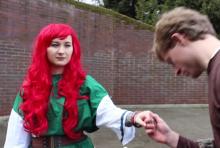When UW history major Brittany Freedman arrived for the first session of this winter's course on the Military History of the Ancient World, she expected to encounter the normal assortment of readings, exams and research papers. But she was surprised to discover that much of her grade would hinge on a very non-traditional assignment: a group project in which she and up to a dozen of her classmates would collaborate on a film depicting an important historical figure or event covered in the class.
After some initial misgivings, Freedman—whose team portrayed the life of the Celtic queen Boudicca—found that the unusual assignment inspired the class to dive into the past in a whole new way. "This kind of project takes you past the names and dates, to allow you to learn more about the culture and human experiences of the past," she noted. At the same time, she also liked how the assignment helped her build connections with peers from other UW programs. "The use of different media helped people who aren't normally so excited about history really engage with the class and with each other."
The instructor, Mira Green, who recently earned a Ph.D. from the UW History Department, hoped for just such results when she designed the assignment. "With this project, I wanted to do three things," Green recalled. "First, to create a vibrant community and a culture of talk within the class; second, to allow students to harness real-world skills, work as co-authors, and showcase their particular skills; and third, to encourage students to question the ways modern filmmakers appropriate the power of historical images." In pursuit of these goals she designed the quarter-long multimedia assignment to include academic research, primary-source analysis, co-authored historical essays, and advertising collateral, along with the culminating film production.
J. J. Woodley, a business and English major at UW whose team depicted the Siege of Masada, especially valued the way the project exercised practical life skills. "It's rare in the humanities to have a group project as large as ten or twelve people," she noted. "To learn how to coordinate and communicate effectively, and work together in a group that big is a great skill to develop." And the results? "It was a blast! Everyone stepped up and did the work. Everyone had a chance to bring their talents to the table and show what they could do."
During the week of March 9th, the class was finally able to enjoy the fruits of their labors, with a five-day film festival. Complete with screenings, refreshments and commentary by the amateur filmmakers, the sessions surpassed even Green's high expectations for her students. "I was just overwhelmed by how they took over the project and ran with it," she recapped. "I'm impressed with their creativity, but also by how much history they took in, and how hard they've worked to depict it fairly."
Green's students appreciated her leadership, and also appreciated how the assignment taught them to see their classmates with new eyes. For Alice Newberry, who was also a part of the Boudicca team, teamwork formed a critical part of the learning experience. "Dr. Green gave all of us the opportunity to learn in different ways," she said, "and I feel I learned even more by having the chance to work with teammates who look at history in different ways than I do."
